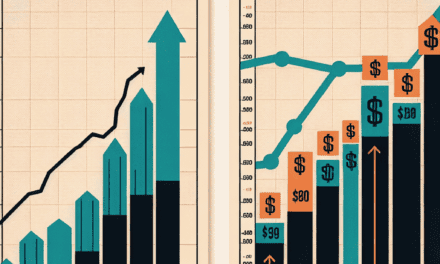“Retire in 5: Turning $1.45M and $5K Monthly into Your Dream Future!”
Introduction
Retirement planning is a crucial aspect of financial management, requiring careful consideration of assets, income streams, and future expenses. For individuals or couples contemplating retirement within a five-year horizon, having a substantial nest egg and additional income sources can significantly influence the feasibility of this goal. With $1.45 million in savings and a steady $5,000 monthly rental income, the prospect of retiring comfortably becomes a tangible possibility. This scenario necessitates a thorough evaluation of current and projected financial needs, investment strategies, and lifestyle aspirations to determine if these resources can sustain a desired standard of living throughout retirement. By analyzing factors such as inflation, healthcare costs, and potential market fluctuations, individuals can develop a comprehensive plan to ensure financial security and peace of mind in their golden years.
Evaluating Financial Independence: Is $1.45M Enough for a 5-Year Retirement Plan?
Evaluating financial independence is a crucial step for anyone considering early retirement, especially when contemplating a timeline as short as five years. The question of whether $1.45 million, supplemented by a $5,000 monthly rental income, is sufficient to retire comfortably is complex and multifaceted. To address this, one must consider various factors, including lifestyle expectations, inflation, healthcare costs, and investment strategies.
Firstly, understanding your lifestyle expectations is paramount. The amount of money required for retirement largely depends on the lifestyle you wish to maintain. If your current lifestyle is modest and you plan to continue living similarly, $1.45 million, along with the additional rental income, might suffice. However, if you envision a retirement filled with travel, luxury, or other costly activities, your financial needs may be significantly higher. Therefore, it is essential to create a detailed budget that accounts for all potential expenses, including housing, food, transportation, and leisure activities.
Moreover, inflation is a critical factor that can erode the purchasing power of your savings over time. Historically, inflation rates have averaged around 3% per year, which means that the cost of living could double in approximately 24 years. Consequently, it is vital to ensure that your retirement savings and income streams can keep pace with inflation. This might involve investing a portion of your savings in assets that historically outpace inflation, such as stocks or real estate.
Healthcare costs are another significant consideration. As individuals age, healthcare expenses tend to increase, and these costs can be substantial. It is crucial to factor in potential medical expenses, including insurance premiums, out-of-pocket costs, and long-term care. Having a comprehensive healthcare plan and possibly setting aside a dedicated healthcare fund can provide peace of mind and financial security.
Investment strategies also play a pivotal role in determining whether $1.45 million is sufficient for retirement. A well-diversified investment portfolio can generate returns that help sustain your retirement savings over the long term. It is advisable to consult with a financial advisor to develop an investment strategy that aligns with your risk tolerance and retirement goals. This strategy should include a mix of growth-oriented investments, such as equities, and more stable income-generating assets, like bonds or dividend-paying stocks.
Additionally, the $5,000 monthly rental income can be a valuable supplement to your retirement savings. However, it is important to consider the potential risks associated with rental properties, such as vacancies, maintenance costs, and market fluctuations. Ensuring that you have a contingency plan for these scenarios can help maintain a steady income stream.
In conclusion, while $1.45 million and a $5,000 monthly rental income may be sufficient for some individuals to retire in five years, it is not a one-size-fits-all solution. A thorough evaluation of your personal financial situation, lifestyle expectations, and potential risks is essential. By considering these factors and planning accordingly, you can make informed decisions about your retirement and work towards achieving financial independence.
Maximizing Rental Income: Strategies to Boost Your $5K Monthly Earnings
Maximizing rental income is a crucial strategy for those looking to retire comfortably, especially when aiming to do so within a relatively short timeframe. For individuals with a retirement goal of five years and a financial base of $1.45 million, supplemented by a $5,000 monthly rental income, optimizing this income stream can significantly enhance financial security. To achieve this, it is essential to explore various strategies that can boost rental earnings, ensuring a more robust and reliable income source during retirement.
One effective approach to maximizing rental income is to enhance the property’s appeal through strategic upgrades and renovations. By investing in modern amenities and ensuring the property is well-maintained, landlords can justify higher rental rates. For instance, updating kitchens and bathrooms, installing energy-efficient appliances, and improving curb appeal can attract higher-paying tenants. Additionally, offering features such as high-speed internet, smart home technology, and security systems can further increase the property’s value and desirability.
Moreover, understanding the local rental market is vital for setting competitive yet profitable rental rates. Conducting thorough market research to analyze comparable properties in the area can provide insights into appropriate pricing strategies. This knowledge allows landlords to adjust their rates in line with market trends, ensuring they remain competitive while maximizing income. Furthermore, staying informed about local economic conditions and demographic shifts can help anticipate changes in demand, enabling proactive adjustments to rental strategies.
Another strategy to consider is diversifying the rental portfolio. By investing in multiple properties or exploring different types of rental opportunities, such as short-term vacation rentals or commercial properties, landlords can spread risk and increase potential income streams. Short-term rentals, in particular, can offer higher returns compared to traditional long-term leases, especially in popular tourist destinations. However, it is important to weigh the potential benefits against the increased management and maintenance demands associated with such properties.
In addition to diversifying the portfolio, landlords can explore value-added services to enhance tenant satisfaction and retention. Offering services such as regular cleaning, landscaping, or maintenance packages can justify higher rental rates and reduce tenant turnover. Happy tenants are more likely to renew leases, providing a stable and continuous income stream. Furthermore, fostering positive landlord-tenant relationships through clear communication and responsive management can enhance tenant loyalty and encourage long-term occupancy.
Tax optimization is another critical aspect of maximizing rental income. Landlords should consult with financial advisors or tax professionals to ensure they are taking full advantage of available deductions and credits. Expenses such as mortgage interest, property taxes, insurance, and maintenance costs can often be deducted, reducing taxable income and increasing net earnings. Additionally, understanding the implications of different ownership structures, such as forming a limited liability company (LLC), can provide further tax benefits and liability protection.
Finally, leveraging technology can streamline property management and enhance efficiency. Utilizing property management software can simplify tasks such as rent collection, maintenance requests, and tenant communication, reducing administrative burdens and allowing landlords to focus on strategic growth. Additionally, digital marketing tools can expand the reach of rental listings, attracting a broader pool of potential tenants and reducing vacancy periods.
In conclusion, maximizing rental income is a multifaceted endeavor that requires a combination of strategic property enhancements, market awareness, portfolio diversification, tenant satisfaction initiatives, tax optimization, and technological integration. By implementing these strategies, individuals can significantly boost their $5,000 monthly rental income, thereby strengthening their financial position and increasing the likelihood of achieving a comfortable retirement within their desired timeframe.
Investment Strategies: Growing Your Retirement Fund Beyond $1.45M
Retirement planning is a multifaceted endeavor that requires careful consideration of various financial elements to ensure a comfortable and sustainable future. For individuals contemplating retirement within a five-year horizon, with a nest egg of $1.45 million and an additional $5,000 in monthly rental income, strategic investment decisions become paramount. The primary objective is to grow the retirement fund beyond its current value while maintaining a balance between risk and return. To achieve this, a diversified investment strategy is essential, as it can mitigate risks and enhance potential returns.
Initially, it is crucial to assess the current asset allocation within the $1.45 million portfolio. A well-diversified portfolio typically includes a mix of equities, fixed-income securities, and alternative investments. Equities, or stocks, are often considered the growth engine of a portfolio due to their potential for high returns. However, they also come with increased volatility. Therefore, it is advisable to allocate a portion of the portfolio to blue-chip stocks or index funds, which offer stability and steady growth. Additionally, incorporating dividend-paying stocks can provide a reliable income stream, complementing the rental income.
In contrast, fixed-income securities, such as bonds, offer lower returns but provide stability and regular interest payments. Given the current low-interest-rate environment, it may be beneficial to explore bonds with varying maturities and credit qualities to optimize returns. Furthermore, inflation-protected securities can safeguard the portfolio against the eroding effects of inflation, ensuring that purchasing power is maintained over time.
Alternative investments, including real estate, commodities, and hedge funds, can further diversify the portfolio. Real estate investments, in particular, can be an attractive option given the existing rental income stream. By reinvesting a portion of this income into additional properties or real estate investment trusts (REITs), investors can potentially enhance their income and capital appreciation. Commodities, such as gold and silver, can act as a hedge against market volatility and inflation, providing a layer of security to the overall portfolio.
Moreover, it is essential to consider the tax implications of investment decisions. Tax-efficient strategies, such as utilizing tax-advantaged accounts like IRAs or 401(k)s, can significantly impact the growth of the retirement fund. Additionally, understanding the tax treatment of different investment vehicles can help in optimizing after-tax returns.
As retirement approaches, it is prudent to gradually shift the portfolio towards more conservative investments to preserve capital. This transition can be achieved by increasing the allocation to fixed-income securities and reducing exposure to high-risk equities. However, maintaining a certain level of equity exposure is important to ensure continued growth and to combat inflation.
In conclusion, growing a retirement fund beyond $1.45 million within a five-year timeframe requires a strategic and diversified investment approach. By carefully balancing equities, fixed-income securities, and alternative investments, while considering tax implications and risk tolerance, individuals can enhance their financial security in retirement. The additional $5,000 monthly rental income provides a valuable supplement, allowing for greater flexibility in investment choices. Ultimately, a well-structured investment strategy, tailored to individual goals and circumstances, can pave the way for a financially secure and fulfilling retirement.
Budgeting for Early Retirement: How to Manage Expenses with $5K Monthly Income
Retirement planning is a multifaceted endeavor that requires careful consideration of various financial elements to ensure a comfortable and sustainable lifestyle. For individuals contemplating early retirement with a nest egg of $1.45 million and a monthly rental income of $5,000, effective budgeting becomes paramount. The primary objective is to manage expenses in a manner that aligns with the available resources while safeguarding against unforeseen financial challenges.
To begin with, understanding the significance of a well-structured budget is crucial. A budget serves as a financial blueprint, guiding retirees in allocating their resources efficiently. With a monthly rental income of $5,000, it is essential to categorize expenses into fixed and variable costs. Fixed expenses, such as housing, utilities, and insurance, are predictable and recur monthly. Conversely, variable expenses, including groceries, entertainment, and travel, can fluctuate and require more flexible management.
Transitioning to the specifics, housing is often the most significant expense in a retiree’s budget. If the retiree owns their home outright, this can significantly reduce monthly outflows. However, if a mortgage remains, it is vital to account for this in the fixed expenses category. Additionally, property taxes and maintenance costs should not be overlooked, as they can impact the overall financial picture.
Healthcare is another critical consideration in retirement budgeting. As individuals age, healthcare costs tend to rise, necessitating a robust plan to cover medical expenses. It is advisable to explore health insurance options, such as Medicare or private insurance, to mitigate potential financial burdens. Allocating a portion of the monthly income to a health savings account can also provide a safety net for unexpected medical expenses.
Moreover, inflation is an inevitable factor that can erode purchasing power over time. To counteract this, retirees should consider investing a portion of their $1.45 million nest egg in inflation-protected securities or diversified portfolios that offer growth potential. This strategy can help maintain the real value of their assets, ensuring that their financial resources keep pace with rising costs.
In addition to managing expenses, it is prudent to establish an emergency fund. This fund acts as a financial cushion, providing liquidity in times of need without disrupting the overall budget. Ideally, the emergency fund should cover three to six months’ worth of living expenses, offering peace of mind and financial stability.
Furthermore, retirees should periodically review and adjust their budget to reflect changes in their financial situation or lifestyle preferences. Regular assessments allow for timely modifications, ensuring that the budget remains aligned with long-term goals. Engaging with a financial advisor can provide valuable insights and guidance, helping retirees navigate complex financial landscapes and make informed decisions.
In conclusion, retiring with $1.45 million and a $5,000 monthly rental income is feasible with meticulous budgeting and strategic financial planning. By categorizing expenses, accounting for inflation, and maintaining an emergency fund, retirees can effectively manage their resources and enjoy a fulfilling retirement. Ultimately, the key lies in balancing current needs with future aspirations, ensuring a financially secure and rewarding retirement journey.
Risk Management: Protecting Your Retirement Savings and Rental Income
Retirement planning is a multifaceted endeavor that requires careful consideration of various financial elements to ensure a secure and comfortable future. One of the critical aspects of this planning process is risk management, which involves protecting both your retirement savings and any additional income streams, such as rental income. For individuals contemplating retirement in five years with $1.45 million in savings and a $5,000 monthly rental income, understanding and mitigating potential risks is essential to safeguarding their financial well-being.
To begin with, it is crucial to assess the stability and growth potential of your retirement savings. With $1.45 million earmarked for retirement, the primary concern is preserving the capital while generating sufficient returns to support your lifestyle. Diversification is a key strategy in risk management, as it helps to spread potential risks across various asset classes. By investing in a mix of stocks, bonds, and other financial instruments, you can reduce the impact of market volatility on your portfolio. Additionally, considering the inclusion of inflation-protected securities can help maintain the purchasing power of your savings over time.
Moreover, it is important to evaluate the sustainability of your rental income. A $5,000 monthly rental income can significantly supplement your retirement savings, but it is not without its risks. Factors such as property maintenance, tenant turnover, and market fluctuations can affect the consistency of this income stream. To mitigate these risks, consider setting aside a portion of your rental income for property upkeep and unexpected expenses. Furthermore, maintaining a diversified portfolio of rental properties, if feasible, can help reduce the impact of localized market downturns on your overall income.
Insurance plays a vital role in protecting both your retirement savings and rental income. Health insurance is particularly important, as medical expenses can quickly deplete your savings if not adequately covered. Long-term care insurance is another consideration, as it can provide financial support in the event of a prolonged illness or disability. For your rental properties, landlord insurance can protect against property damage and liability claims, ensuring that your rental income remains secure.
In addition to these measures, it is prudent to establish an emergency fund. This fund acts as a financial buffer, allowing you to cover unexpected expenses without dipping into your retirement savings or relying on rental income. A well-funded emergency account can provide peace of mind and financial stability, particularly during economic downturns or personal financial crises.
Furthermore, it is advisable to regularly review and adjust your retirement plan to reflect changes in your financial situation and market conditions. Engaging with a financial advisor can provide valuable insights and guidance, helping you to navigate the complexities of retirement planning and risk management. By staying informed and proactive, you can make informed decisions that align with your long-term financial goals.
In conclusion, retiring in five years with $1.45 million in savings and a $5,000 monthly rental income is an achievable goal, provided that you implement effective risk management strategies. By diversifying your investments, safeguarding your rental income, securing appropriate insurance coverage, and maintaining an emergency fund, you can protect your financial future and enjoy a comfortable retirement. Through careful planning and ongoing assessment, you can mitigate potential risks and ensure that your retirement years are both financially secure and fulfilling.
Tax Implications: Understanding the Impact on Your $1.45M and Rental Income
When considering retirement planning, understanding the tax implications of your assets and income streams is crucial. For individuals contemplating retirement in five years with $1.45 million in savings and a $5,000 monthly rental income, a comprehensive analysis of tax obligations is essential to ensure financial stability and sustainability. The interplay between these financial components can significantly impact your retirement strategy, and thus, a thorough understanding of the tax landscape is necessary.
To begin with, the $1.45 million in savings, presumably invested in various accounts such as 401(k)s, IRAs, or taxable brokerage accounts, will be subject to different tax treatments. Traditional retirement accounts like 401(k)s and IRAs offer tax-deferred growth, meaning taxes are paid upon withdrawal. This can be advantageous during retirement when you may be in a lower tax bracket. However, it is important to strategize withdrawals to minimize tax liabilities, especially considering required minimum distributions (RMDs) that begin at age 72. Conversely, Roth IRAs provide tax-free withdrawals, assuming certain conditions are met, which can be a beneficial tool for managing taxable income during retirement.
In addition to savings, the $5,000 monthly rental income introduces another layer of tax considerations. Rental income is generally considered taxable, but the tax code allows for various deductions that can reduce taxable income. These deductions include mortgage interest, property taxes, operating expenses, depreciation, and repairs. Understanding and maximizing these deductions can significantly lower the effective tax rate on rental income. However, it is crucial to maintain accurate records and documentation to substantiate these deductions in the event of an audit.
Moreover, the tax treatment of rental income can vary depending on whether the property is classified as a passive activity or a business. If the rental activity is deemed a business, you may be eligible for the Qualified Business Income (QBI) deduction, which allows for a 20% deduction on qualified business income. This can be a substantial tax-saving opportunity, but it requires meeting specific criteria and understanding the nuances of the tax code.
Transitioning to the broader tax implications, it is essential to consider state taxes, which can vary significantly and impact overall tax liability. Some states have no income tax, while others may tax retirement income and rental income differently. Evaluating the tax environment of your state of residence, or considering relocating to a more tax-friendly state, can be a strategic decision in retirement planning.
Furthermore, estate planning should not be overlooked, as it can have significant tax implications for your heirs. Understanding the current estate tax exemption limits and potential changes in tax legislation is vital for effective estate planning. Utilizing strategies such as gifting, trusts, and charitable donations can help mitigate estate taxes and ensure that your assets are distributed according to your wishes.
In conclusion, while retiring in five years with $1.45 million and $5,000 in monthly rental income is an achievable goal, it requires careful consideration of the tax implications associated with these assets. By strategically managing withdrawals, maximizing deductions, and understanding the broader tax landscape, you can optimize your financial position and ensure a comfortable and sustainable retirement. Consulting with a tax professional or financial advisor can provide personalized guidance tailored to your specific circumstances, helping you navigate the complexities of retirement planning with confidence.
Lifestyle Adjustments: Adapting to a New Financial Reality in Early Retirement
Retirement planning is a multifaceted endeavor that requires careful consideration of various financial and lifestyle factors. For those contemplating early retirement, the prospect of living off a fixed sum, such as $1.45 million, supplemented by a $5,000 monthly rental income, presents both opportunities and challenges. As individuals transition into this new phase of life, it becomes imperative to adapt to a new financial reality, ensuring that resources are managed prudently to sustain a comfortable lifestyle.
To begin with, understanding the implications of early retirement is crucial. Retiring earlier than the traditional age means that individuals will need to stretch their savings over a longer period. This necessitates a thorough evaluation of current and projected expenses, taking into account inflation and potential unforeseen costs. The $1.45 million nest egg, while substantial, must be allocated wisely to cover essential living expenses, healthcare, leisure activities, and any other personal goals. The $5,000 monthly rental income provides a steady cash flow, yet it is essential to consider the variability of rental markets and potential vacancies that could impact this income stream.
Transitioning into early retirement also involves reassessing lifestyle choices. It may be necessary to adopt a more frugal approach to spending, prioritizing needs over wants. This does not imply a drastic reduction in quality of life but rather a strategic adjustment to ensure financial sustainability. For instance, individuals might explore cost-effective alternatives for travel, dining, and entertainment, allowing them to enjoy their retirement years without compromising their financial security.
Moreover, healthcare is a significant consideration in early retirement planning. Without employer-sponsored health insurance, retirees must navigate the complexities of private health insurance or government programs, which can be costly. Allocating a portion of the retirement fund to cover these expenses is prudent, as healthcare costs tend to rise with age. Additionally, maintaining a healthy lifestyle can mitigate some healthcare expenses, emphasizing the importance of regular exercise, a balanced diet, and preventive care.
Investment strategies also play a pivotal role in adapting to a new financial reality. With a longer retirement horizon, it is essential to strike a balance between preserving capital and achieving growth. Diversifying investments across various asset classes can help manage risk and provide a buffer against market volatility. Consulting with a financial advisor can offer valuable insights into optimizing the investment portfolio to align with retirement goals and risk tolerance.
Furthermore, early retirees should consider the psychological and social aspects of this life transition. The shift from a structured work environment to a more flexible lifestyle can be both liberating and challenging. Engaging in meaningful activities, whether through volunteering, hobbies, or part-time work, can provide a sense of purpose and fulfillment. Building a supportive social network is equally important, as it can enhance emotional well-being and provide opportunities for shared experiences.
In conclusion, retiring in five years with $1.45 million and a $5,000 monthly rental income is an attainable goal, provided that individuals are willing to make necessary lifestyle adjustments. By carefully managing expenses, planning for healthcare, adopting sound investment strategies, and addressing the psychological aspects of retirement, individuals can successfully navigate this new financial reality. Ultimately, the key to a fulfilling early retirement lies in balancing financial prudence with the pursuit of personal happiness and well-being.
Q&A
1. **Question:** What is the total annual income from the $5K monthly rental income?
**Answer:** The total annual income from the $5K monthly rental income is $60,000.
2. **Question:** What factors should be considered to determine if $1.45M is sufficient for retirement in 5 years?
**Answer:** Factors to consider include expected annual expenses, inflation, healthcare costs, life expectancy, investment returns, and any other sources of income.
3. **Question:** How can the 4% rule be applied to determine the annual withdrawal from $1.45M?
**Answer:** According to the 4% rule, you can withdraw 4% of your retirement savings annually. For $1.45M, this would be $58,000 per year.
4. **Question:** What is the combined annual income from the 4% withdrawal and rental income?
**Answer:** The combined annual income would be $58,000 (from the 4% withdrawal) + $60,000 (from rental income) = $118,000.
5. **Question:** How can inflation impact retirement planning over the next 5 years?
**Answer:** Inflation can erode purchasing power, meaning that the same amount of money will buy less in the future. It’s important to account for inflation in retirement planning to ensure that income keeps pace with rising costs.
6. **Question:** What role do investment returns play in determining the sustainability of retirement savings?
**Answer:** Investment returns can help grow retirement savings and offset withdrawals. Positive returns can extend the longevity of the savings, while negative returns can deplete them faster.
7. **Question:** What are some strategies to ensure that retirement savings last throughout retirement?
**Answer:** Strategies include diversifying investments, adjusting withdrawal rates based on market conditions, reducing expenses, considering part-time work, and delaying Social Security benefits to increase future payouts.
Conclusion
Retirement planning is a complex process that requires careful consideration of various factors, including current savings, expected income, expenses, and lifestyle goals. In the scenario of retiring in 5 years with $1.45 million in savings and $5,000 in monthly rental income, several key points must be evaluated. First, the adequacy of the $1.45 million depends on the expected annual withdrawal rate, inflation, and investment returns. A commonly used rule of thumb is the 4% withdrawal rate, which would provide $58,000 annually from the savings. Combined with the $60,000 annual rental income, this totals $118,000 per year before taxes.
Next, it’s crucial to assess whether this income can sustain the desired lifestyle, considering factors such as healthcare costs, travel, and other personal expenses. Additionally, the stability and reliability of the rental income should be evaluated, including potential vacancies and maintenance costs. Inflation can erode purchasing power over time, so investments should be structured to provide growth potential.
Finally, it’s important to consider other sources of income, such as Social Security or pensions, and the timing of their commencement. In conclusion, while retiring in 5 years with $1.45 million and $5,000 monthly rental income is feasible for some, it requires a detailed analysis of expenses, investment strategy, and risk tolerance to ensure financial security throughout retirement. Consulting with a financial advisor can provide personalized insights and strategies to achieve retirement goals.





